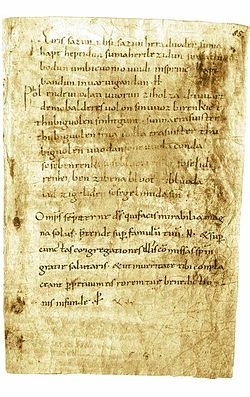
The Merseburg Incantations (German: die Merseburger Zaubersprüche) are two Old High German magic incantations or charms recorded in a theological manuscript from Fulda dating to the 9th century.[1] These short metrical works are commonly considered to be the only known texts which record continental Germanic pagan beliefs in Old High German.[2] They were discovered by Georg Waitz in the library of the Merseburg Cathedral in 1841 and published for the first time by Jacob Grimm in 1842.[3]
Date
Grimm (1865), arguing from the morphological features of key terms in the texts, was first to suggest that the Merseburg Incantations were probably composed long before they were recorded in the 10th century, perhaps as much as two or three centuries.[4] The date of composition has since been narrowed down to the middle of the 8th century.[5]
Language
The language of the Incantations is commonly listed as Old High German. Grimm (1865), after a detailed examination of the texts, concludes that the language is neither pure Old High German, nor Old Saxon, but rather something between these two, possibly Thuringian in origin.[6] Thomas (1909) considers the language to be Frankish.[7]
Form
Like most medieval German charms, the Merseburg Incantations are each composed of two parts: an epic historiola, which narrates a mythological precedent for the action which is to be affected, and an incantation proper.[8] DuBois (1999) proposes that the purpose of the historiola is to remind the addressee of his or her benevolence and/or past success and to thereby persuade the addressee towards a similar action in the present, while the incantation proper may be a repetition of words believed to have been spoken by the addressee during such an act.[9]